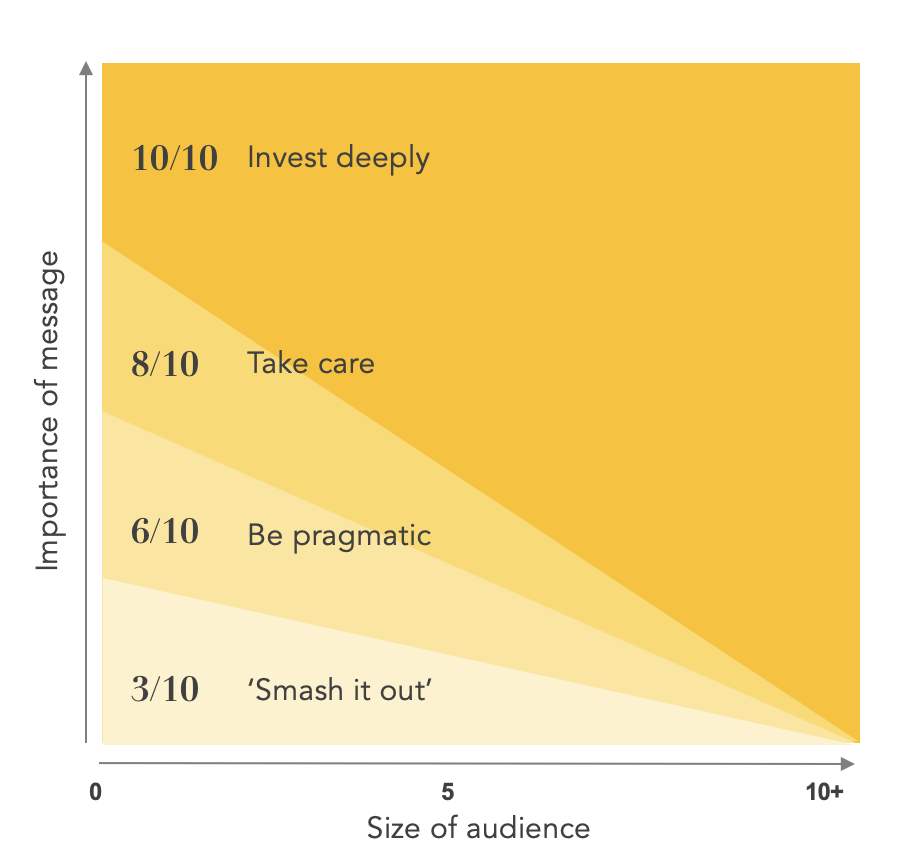Do you wonder how much effort to invest in different pieces of communication?
Do you prioritise according to …
- who your audience is
- the type of document it is (email, paper, PowerPoint?)
- how much time you have to prepare it, or
- the business impact it will generate?
Let's use two routine examples that emerged in my coaching work this week to think about this and refine how we think about each of them using a simple framework.
First, two routine examples to set the scene
Imagine you have two emails to prepare today:
Example 1: A 250 word email seeking leadership support. You need your five-person leadership team to agree to change the course of your project in light of complications caused by an unexpected technical glitch.
The change doesn't require any extra budget but does require your team to change their priorities which will lead to deprioritising another important project.
Example 2: A 150 word email to 3,000 staff. You have discovered a new security vulnerability in the latest Google Chrome release and need the whole organisation to manually update their browser immediately.
The steps that each of the 3,000 people need to take are simple but critical and you are aware that many of your employees are not ‘tech savvy' and may need explicit instructions to complete the update.
So, how do you decide how to proceed?
Next: a simple framework to help you prioritise your effort

By thinking about two important dimensions: impact and size of audience, we get to a different conclusion.
This allows us to correlate our effort and our end game by prioritising our effort according to a balance between the impact the communication will deliver and the risk of slowing the organisation down (or worse) if it goes wrong.
And … a counter-intuitive conclusion
Both of these examples need ‘proper' investment but using this approach we would pay more attention to the Google Chrome vulnerability email. Here's why:
Although the email to all staff seemed fairly simple, the risks and potential time loss were both higher than that for the leadership email.
If the staff email was poorly done, the cost to the organisation would have been substantial
- The steps for updating the Chrome vulnerability were easy if you were ‘tech savvy', but could be time consuming if not. In the real situation it proved to be easy to convolute the steps confusing colleagues and leaving a real possibility that they would give up. Aggregate this over 3,000 people and the cost to the organisation of getting it wrong is pretty big.
- The current risk of being hacked is also intense for this organisation, making the risk of not updating the browsers higher than normal.
If the leadership email was poorly done, the cost would have been less significant
- The cost to the organisation of the ‘hourly rate' of these leaders taking time to ask questions to clarify the message is less than the potential time cost of the staff email
- The risks to the organisation are minimal as no extra budget or skills were required and time lost could be caught up in other ways if the project needed to return to the original schedule
- The project leader is likely to have other opportunities to put their case in the not too distant future should there be confusion stemming from the email
I hope that provides some food for thought this week and look forward to sharing more ideas with you next week.
Kind regards,
Davina
‘Pitch your boss' kit to help you this budget season
If you want your manager to invest in your development, you need to do your homework before you have the conversation. Your manager will want to know exactly why this is the right program for you and how it will help the team and the organisation. We have provided a brochure, a draft script and some steps to follow to help you prepare for your conversation. Clarity First opens again in September
PRESENTED BY DAVINA STANLEY
I love what I do.
I help senior leaders and their teams prepare high-quality papers and presentations in a fraction of the time.
This involves 'nailing' the message that will quickly engage decision makers in the required outcome.
I leverage 25+ years' experience including
- learning structured thinking techniques at McKinsey in Hong Kong in the mid 1990s before coaching and training their teams globally as a freelancer for a further 15 years
- being approved to teach the Pyramid Principle by Barbara Minto in 2009
- helping CEOs, C-suite leaders and their reports deeply understand their stakeholder needs and communicate accordingly
- seeing leaders cut the number of times they review major papers by ~30% and teams cut the amount of time they take to prepare major papers by ~20%*
- watching senior meetings focus on substantive discussions and better decisions rather than trying to clarify the issue
My approach helps anyone who needs to engage senior leaders and Boards.
Recent clients include 7Eleven, KPMG, Mercer, Meta, Woolworths.
Learn more at www.clarityfirstprogram.com
(*) Numbers are based on 2023 client benchmarking results.


